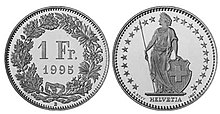One-franc piece
| One-franc piece | |
|---|---|

|
|
| Data | |
| Alloy: | 75% copper 25% nickel |
| Weight: | 4.40 g |
| Diameter: | 23.20 mm |
| Thickness: | 1.55 mm |
| Edge embossing: | ribbed |
| Artist: | Albert Walch (design), Antoine Bovy (coin engraver) |
The Einfrankenstück even Einfränkler or Fränkler called, is a circulating coin of Switzerland worth one Swiss franc .
Coin image
The Franking shows the coin value and the year in a wreath as a motif on the obverse (left part of the wreath: oak leaves, right part of the wreath: rust-leaved alpine rose). On the back there is a standing Helvetia and 23 five-pointed star, the same as in Zweifränkler and the Fünfzigräppler . For more information see two francs .
The coins from 1850, 1851, 1857, 1860 and 1861 show the motif of the seated Helvetia on the picture side based on a design by Friedrich Fisch. The motif, which has been retained since then, was only introduced in 1875 based on a design by Albert Walch .
The mint mark "B" below the wreath on the value side stands for the Federal Mint in Bern. Some of the issues from 1968 and 1969 were minted in London, with those from 1968 not bearing a mintmark, but those from 1969 also bearing a “B”, which means that they cannot be distinguished from the coins from Bern. From 1970 to 1985 the mintmark was omitted from all coins; these all come from Bern.
composition
Like the fifty cent coin , the two-franc coin and the five- franc coin , the one- franc coin originally (until 1967) was made of a silver alloy . The alloy was exchanged after the precious metal value exceeded the face value. Due to the former silver alloy Einfränkler despite the five-fold higher nominal value only slightly larger and heavier, and even thinner than that's twenty cents piece .
Due to the original silver alloy, the Einfränkler is exactly half as heavy as the Zweifänkler, according to the face values, but twice as heavy as the Fifty Cent coin.
Silver Franconians are out of course, but still occasionally in circulation. Since the alloy difference is only noticeable to the experienced observer and if the year of issue is observed, these are accepted for payment without hesitation. However, the sale of such coins to collectors is more lucrative.
Individual evidence
- ↑ Ruedi Kunzmann: The silver coin crisis in Switzerland of 1968 and the activity of the Royal Mint , London In: Schweizer Münzblätter Vol. 50, No. 200, 2000, ISSN 0016-5565 , pp. 68-72.